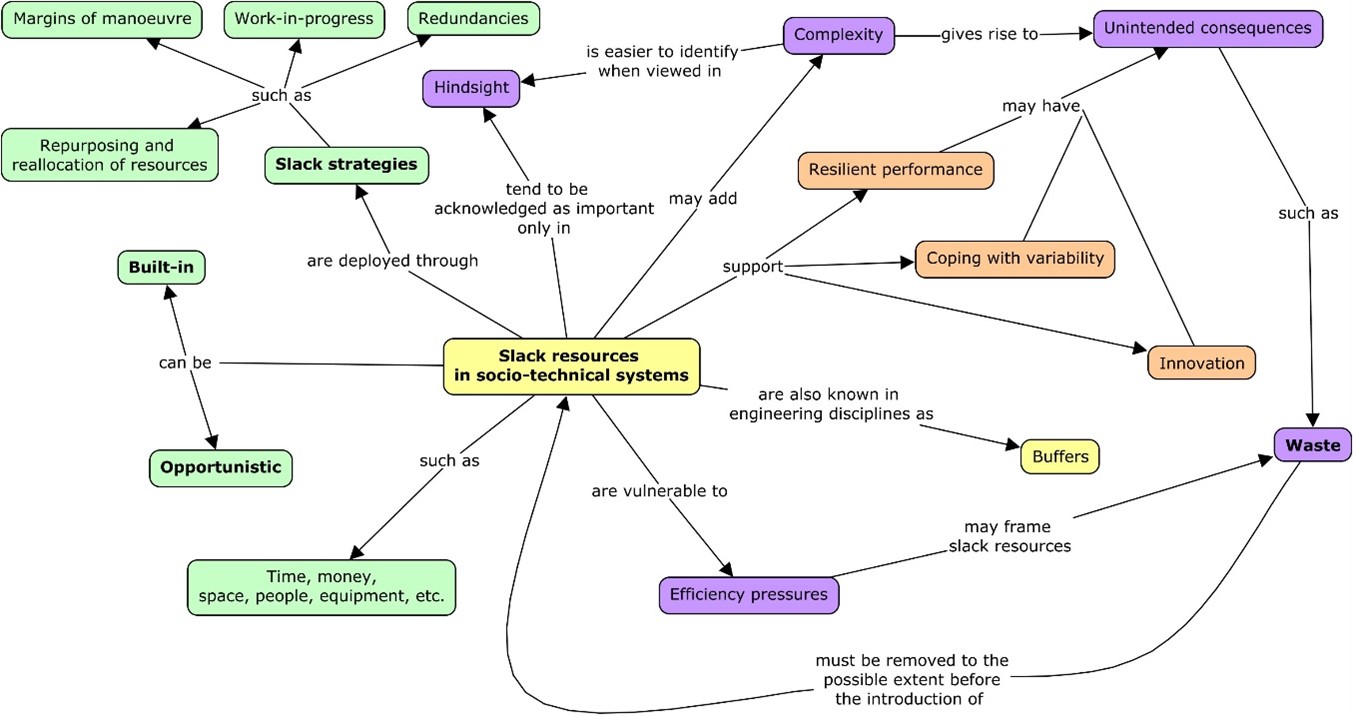
By Tarcisio Abreu Saurin (Industrial Engineering Post-Graduation Program, Federal University of Rio Grande do Sul, Porto Alegre, Brazil)
The provision of slack is a common approach for coping with variability, as it reduces interdependencies and slows down the propagation of variability (Safayeni and Purdy, 1991). In fact, slack is not only useful to address the undesired aspects of variability, but also to exploit opportunities arising from it – e.g., a surge in demand that offers new market opportunities. Furthermore, slack is an asset for innovation, as it allows a forgiving environment for trial and error through experimentation (Beum-Nyum, 2017). Indeed, slack is also valuable for the resilience of socio-technical systems, since it supports performance adjustment and the maintenance of the system’s core functions, during both expected and unexpected situations (Saurin and Werle, 2017).
Common slack strategies involve the use of redundant components (Clarke, 2005), work-in-progress, margins of manoeuvre (Stephens et al., 2011), repurposing, and reallocation of existing resources. These strategies are accomplished through slack resources, which may take the form of people, time, materials, money, space, equipment, among others.
In loosely-coupled socio-technical systems, there is a chance that expedient, spur-of-the-moment slack resources can be found, even though they were not planned ahead of time (Perrow, 1984). These slack resources are deployed opportunistically, as they play a role as slack even though that was not their original purpose. By contrast, built-in slack resources aim at the control of one or more predefined classes of variability sources.
Examples of the aforementioned taxonomy[1] of slack can be easily found out in a number of everyday systems. An example of the strategy “redundancy”, involving the built-in resource “people”, refers to professionals on standby in emergency departments (EDs). In fact, EDs as a whole are exemplars of the slack strategy “work-in-progress”, as they shield other hospital’s units, such as in-patient wards and ICUs, from variations in demand from the external environment.
The COVID-19 pandemic has made the need for slack resources in healthcare services dramatically visible (Saurin, 2021). From the perspective of built-in slack resources, the need for extra ICU capacity and extra supplies stands out. In turn, examples of opportunistic slack resources abound in the pandemic, such as the adaptation of factories to the production of hand sanitizer and respiratory ventilators, the use of hotel rooms for quarantining international travellers, and the repurposing of drugs. Opportunistic slack resources also resulted from the mixed effects of the pandemic in the occupation of healthcare facilities, as demand for some services plummeted – e.g., suspended elective surgeries freed up operating rooms. Thus, space and staff were reallocated to meet demands from COVID-19 patients. The pandemic also made clear that slack resources are finite and that their provision must go hand-in-hand with the control of variability propagation – this lies at the heart of the widely discussed need for flattening the curve of infections and hospitalizations (Saurin, 2021).
However, slack resources have drawbacks. First, some types of slack resources add elements and therefore complexity to systems. Second, there is a possibility that slack resources grow disorderly over time, to the point of being randomly distributed across the system, and thus not matching the sources of variability (Saurin and Werle, 2017). Third, slack resources imply a cost, thus creating the problem of balancing costs against benefits (Saurin and Ferreira, 2021). Too much slack can equate to waste, which corresponds to the use of more resources than what would be reasonably accepted to produce a desired outcome (Shingo, 1981). Too little slack can make the system vulnerable even to everyday variability. Therefore, a major problem for designers of resilient socio-technical systems involves the definition of the right amount of the right types of slack resources.
The concept map below summarizes the main points of this technical note, in addition to bringing some additional insights. Starting from the centre of the map, it is possible to obtain insight into the taxonomy of slack resources (in green), their purpose (in orange), and possible drawbacks (in purple).

For more info, please e-mail: saurin@ufrgs.br
References
Beum-Nyun, K, Nam, L., Wi, J., Jong-Keon, L. 2017. The effects of slack resources on firm performance and innovation in the Korean pharmaceutical industry. Asian Journal of Technology Innovation, 25:3, 387-406.
Clarke D. 2005. Human redundancy in complex, hazardous systems: a theoretical framework. Safety Science;43:655-677.
Perrow, C. 1984. Normal Accidents: Living with High-Risk Technologies, Princeton University Press, Princeton.
Safayeni, F., Purdy, L., 1991. A behavioral case study of just-in-time implementation. Journal of Operations Management, 10 (2), 213-228.
Saurin, T.A. 2021. A complexity thinking account of the COVID-19 pandemic: Implications for systems-oriented safety management. Safety Science, 134, 105087.
Saurin, T.A.; Ferreira, D.M.C. 2021. Slack resources in healthcare systems: resilience or waste? In: Rapport, F.; Braithwaite, J. (Editors), Transforming Healthcare with Qualitative Research, pp. 53-59. Oxon, Routledge.
Saurin, T.A.; Werle, N.B. 2017. A framework for the analysis of slack in socio-technical systems. Reliability Engineering and Systems Safety,167, 439-451.
Shingo, S. 1981. A study of the Toyota Production System from an industrial engineering viewpoint. Productivity Press.
Stephens R.J, Woods, D.D, Branlat, M., Wears R.L. 2011. Colliding dilemmas: interactions of locally adaptive strategies in a hospital setting. Proceedings of the 4th Resilience Engineering Symposium. Sophia Antipolis: Resilience Engineering Association; 2011. p 256 -262.
[1] An expanded taxonomy of slack resources was proposed by Saurin and Werle (2017).
